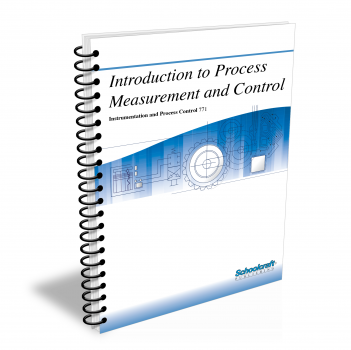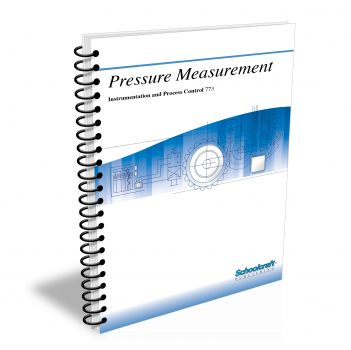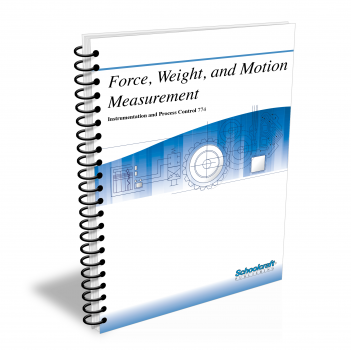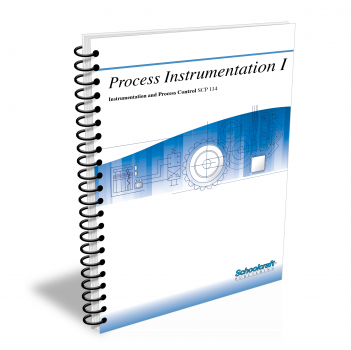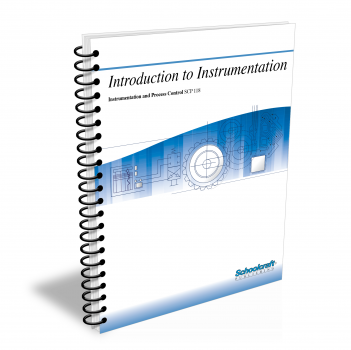Process Instrumentation II
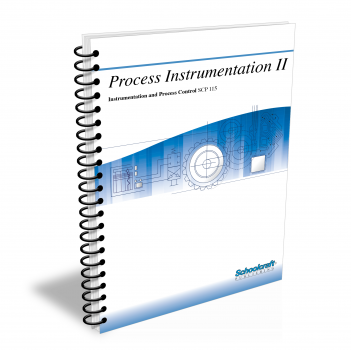
Course Number: 8115
A perfect complement to Process Instrumentation I, or as a stand alone, the Process Instrumentation II textbook covers symbology, control loops and related topics including a brief introduction to PLCs and continuing with its applied workplace approach there is an overview of troubleshooting as well.
Does your curriculum require additional topics not included in this textbook? Build a customized version of the Process Instrumentation II textbook below.
Recommended Contact Hours – 32
Preview a Chapter
Available Supporting Material
- Table of Contents
- Exam Copies
- Suggested Titles
Table of Contents
Chapter 1: Process Control Symbols and Drawings
Topics: Instrument identification; Symbols used in process control; Symbol recognition; Piping and instrument drawing; Location drawing; Loop diagram; Installation drawing; Wiring diagram; Other kinds of symbols
Learning Objectives:
- Recognize standard symbols used in process control diagrams.
- Describe a process control system through the use of instrument symbols.
- Recognize and use four kinds of process control diagrams.
- Analyze a process control drawing for the elements, signal flow, and process flow.
Chapter 2: Flowcharts and Electrical Diagrams
Topics: Sequence of operation; Flowchart; Switches; Relays; Motor starters; Electrical elementary diagram; Pump system schematic diagram; Programmable controller diagram; Electronic symbols
Learning Objectives:
- Convert sequence-of-operation text to a flowchart.
- Read electrical and electronic control diagrams and drawings.
- Recognize symbols used on electrical and electronic diagrams, including those for PLCs and SAMA logic.
- Convert electrical diagrams to PLC diagrams.
- Discuss the role of computers in process control.
Chapter 3: Fundamentals of Control Loops
Topics: Definitions; Process sensors; Sensor characteristics; Controllers; Recorders; Signal conditioners; Final control elements
Learning Objectives:
- Explain the difference between an open loop and a closed loop.
- Define error, feedback, disturbance, and feedforward control.
- List several kinds of process sensors and describe the operation of each.
- Explain how accuracy, resolution, sensitivity, linearity, and step response affect sensor operation.
- Describe the functions of process controllers, recorders, signal conditioners, and final control elements.
- Explain the basic operation of a typical control loop.
Chapter 4: Control Loop Characteristics
Topics: Two-position and floating control; Proportional, integral, derivative, and PID mode; Supervisory control; DDC; DCS
Learning Objectives:
- Describe the difference between continuous and discontinuous control modes and give an example of each.
- Describe the action of the various continuous control modes.
- Define proportional band, reset time, and rate time.
- Discuss the advantages of each of the combination control modes.
- Name several advantages of digital controllers.
- Discuss the differences between supervisory control, direct digital control, and distributed control systems.
Chapter 5: Advanced Control Methods
Topics: Cascade and ratio control system; Feedforward control; Ratio control in a secondary loop; Multivariable control systems
Learning Objectives:
- Describe how a cascade control system works.
- Identify the primary and secondary variables in a cascade loop.
- Compare feedforward and feedback control.
- Identify dependent and independent variables in ratio control.
- Explain the advantage of having a secondary control loop in ratio control.
- Describe how a multivariable control system works and define interaction.
Chapter 6: Loop Dynamics
Topics: Effects of process time lag; Dead time compensation; System stability; Transient response; Gain; Phase shift
Learning Objectives:
- Describe two kinds of process time lags and give an example of each.
- Discuss the effects of capacitance and resistance on loop dynamics.
- State the three main objectives of a well-designed process control system.
- Describe how PI, PD, and PID controllers are adjusted to achieve optimum response.
- Discuss the effects of system gain and phase shift on system stability.
Chapter 7: Loop Protection
Topics: Explosion-proof enclosures; Intrinsically safe instrument systems; Fail-safe mechanisms; Hard and soft constraints; Alarms
Learning Objectives:
- Discuss the classification of hazardous locations as identified in the NEC Handbook.
- Define volatility and flash point, and explain the purpose of a purged enclosure.
- Describe two kinds of explosion-proof enclosures.
- Discuss ways of making a system intrinsically safe.
- Describe examples of fail-safe mechanisms, and differentiate between hard and soft constraints.
- Compare latching and nonlatching alarm systems, and explain the function of annunciators.
- Discuss the purpose and operation of interlocked and sequential control.
Chapter 8: Measuring Conductivity
Topics: Ion concentration; Conductivity probes; Probe, liquid standard, and wire loop calibration; Grab samples; Stack gas analyzers; Maintenance
Learning Objectives:
- Define conductivity and discuss the basic principles governing conductivity.
- Compare the operation of electrode probes and inductive probes.
- Describe two procedures for calibrating conductivity probes.
- Discuss proper installation and maintenance practices for conductivity probes.
- Discuss the operation of stack gas analyzers.
Chapter 9: Measuring pH and ORP
Topics: Temperature and pH; pH and ORP reference and measurement electrodes; Calibration; Probe installation, mounts, and maintenance
Learning Objectives:
- Describe pH and ORP measurement processes.
- Describe the instruments used for the measurement of pH and ORP.
- Discuss calibration procedures for pH and ORP measurement instruments.
- Discuss general installation and maintenance procedures for pH and ORP measurement instruments.
Chapter 10: Optical Measurement
Topics: Transmission-type analyzers; Turbidimeter; Nephelometers; Refractometers; Capacity analyzers; Calibration, installation, and maintenance
Learning Objectives:
- Describe the components that make up an optical analyzer.
- Discuss the basic operating procedures of silica ion and COD optical analyzers, turbidimeters and nephelometers, refractometers, and capacity analyzers.
- Compare procedures for calibrating an optical analyzer with standards, with grab samples, and electronically.
- Discuss installation considerations and basic maintenance procedures for an optical analyzer.
Chapter 11: Measuring Products of Combustion
Topics: Gas, oxygen, carbon dioxide, and carbon monoxide sensors; Calibration; Maintenance
Learning Objectives:
- Identify the main components in the combustion process.
- Describe the various kinds of instruments used for measuring the products of combustion.
- Discuss the principles of operation of instruments that measure the products of combustion.
- Describe the basic maintenance procedures for instruments that measure the products of combustion.
- Discuss the various sampling techniques for measuring the products of combustion.
Chapter 12: Chromatography
Topics: Chromatograph operation; Gas and liquid chromatography; System valves; Detectors; Chromatograms; Calibration and maintenance
Learning Objectives:
- Discuss the principles of chromatograph operation.
- Describe four kinds of detectors used with chromatographs.
- Describe four kinds of liquid chromatog raphs.
- Explain how to read a chromatogram.
- Discuss chromatograph calibration techniques and identify variables that can affect chromatograph accuracy.
- Discuss chromatograph maintenance considerations.
Chapter 13: History and Overview
Topics: SCADA; Microprocessor-based instruments; Distributed control; Personal computers; PLCs; Artificial intelligence; Expert systems; Fuzzy logic; Integrated control systems
Learning Objectives:
- Discuss the history of the application of computers to continuous and batch process control.
- Describe the function of an RTU in a SCADA system.
- Describe the development of distributed control systems from microprocessor-based instruments, including programmable logic controllers.
- Compare the hardware, operating systems, software, and applications of a PC with a household VCR.
- Compare the concepts of artificial intelligence, expert systems, and fuzzy and crisp logic.
Chapter 14: Small Computers in Process Control
Topics: Smart sensors, transmitters, signal conditioners, and final elements; Single and multiloop controllers; Networks; PLCs
Learning Objectives:
- Describe the various kinds of small computers used in process control.
- Explain how a "smart" device differs from its conventional counterpart.
- Discuss the similarities between microprocessor-based instruments and conventional instruments and list several advantages of microprocessor-based instruments.
- Describe the roles of two kinds of PCs (programmable controllers and personal computers) in process control.
Chapter 15: DCS Architecture
Topics: Importance of distributed control systems; Distributed control system hardware; Workstations; Remote processing units; Host/guest computers; Transmission system; Distributed control system software; Distributed control system reliability; Peripherals; What is fieldbus?
Learning Objectives:
- Describe the elements of a typical workstation.
- Discuss the functions of remote processing units and host/guest computers in DCSs.
- Compare star, hub, and ring network topologies and token-passing, contention, and polling protocols.
- Explain why today's DCS users must be more computer literate than previously.
- Discuss ways of calculating and ensuring DCS reliability.
- Describe the functions of six typical DCS peripherals.
- List advantages and disadvantages of all-digital process control systems, such as fieldbus.
Chapter 16: DCS Configuration and Operation
Topics: Configuring distributed control systems; Hierarchical displays; Configuring operating and auxiliary displays; Operation
Learning Objectives:
- Describe the basics of a simple configuration process.
- Discuss the preparatory steps required for configuration.
- Describe a typical hierarchical display arrangement and discuss the progression of the configuration process from level to level.
- Discuss the automatic configuration of auxiliary displays.
- Discuss the DCS functions for which the operator is and is not responsible.
Chapter 17: System Integration
Topics: The scope of integration; Total business integration; Discrete processes and manufacturing systems; Flexible manufacturing; Materials control; Statistical process control; Integration of continuous and batch processes
Learning Objectives:
- Discuss the development of integration in industry.
- Describe how continuous and discrete processes fit into the concept of total business integration.
- Describe the purposes of MAP and OSI.
- Discuss the functions of CAD, CADD, CAE, CAM, and cell control in discrete processes.
- Discuss the importance of FMS, MRP, JIT, and MMS in today's integrated industrial plant.
- Explain how SPC ensures quality control in open-loop processes.
- Discuss the advantages of integrating batch, continuous, and discrete processes throughout a plant.
Chapter 18: Instrument Troubleshooting
Topics: Troubleshooting requirements; Knowledge of the equipment; Using manufacturer's literature, Maintenance and repair records; Tools and test instruments; Calibration standards; Troubleshooting techniques; Gathering information; Checking the records; Returning the loop to operation; Inspecting the instrument; In-shop troubleshooting; Recording the repair
Learning Objectives:
- Explain how an understanding of the process and its instrumentation reduces troubleshooting time.
- List at least four kinds of information typically included in a manufacturer's manual or instruction book.
- Describe the contents of an instrument history file and explain its usefulness in troubleshooting.
- Discuss the kinds of tools, including calibration standards, you are apt to use in troubleshooting.
- Describe the steps in a typical troubleshooting procedure and explain how to use a branching troubleshooting chart.
- Describe cascading failure.
Chapter 20: Servicing Fundamentals
Topics: Why is instrument servicing necessary?; Repair modes; Repair records; Failure mode analysis; Maintenance modes; Maintenance records; Calibration modes; Calibration records; Calibration seals; Care of tools and equipment; Shop layout and operations
Learning Objectives:
- Compare methods of on-site and shop repair of malfunctioning instruments.
- Describe the differences between repairing, maintaining, and calibrating instruments.
- Describe the contents of an equipment history file and a process loop file.
- Discuss the benefits of failure mode analysis.
- Describe proper calibration procedures, including use of calibration seals, and explain what NIST-traceable means.
- Describe the typical main sections of an industrial instrument shop.
Request Exam Copies
Exam Copies
Ready to see a copy of our textbooks? After selecting which textbooks you’d like to review for your course, you can submit your request by either logging in or creating an account so we know where to ship your exam copies. A representative from Schoolcraft will contact you to confirm and finish processing your request.
Exam copies are always free and yours to keep.
Selected Exam Copies
none selected
* Maximum of five copies can be ordered
